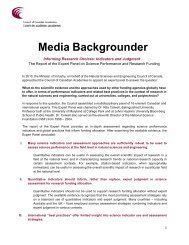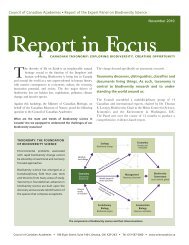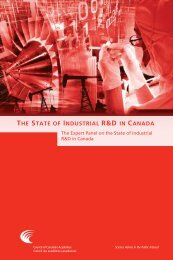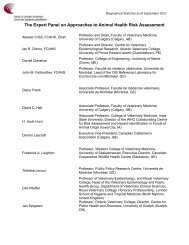an assessment of the evidence - Council of Canadian Academies
an assessment of the evidence - Council of Canadian Academies
an assessment of the evidence - Council of Canadian Academies
- No tags were found...
Create successful ePaper yourself
Turn your PDF publications into a flip-book with our unique Google optimized e-Paper software.
18 Influenza Tr<strong>an</strong>smission <strong>an</strong>d <strong>the</strong> Role <strong>of</strong> PPRE: An Assessment <strong>of</strong> <strong>the</strong> EvidenceIf <strong>the</strong> concentration <strong>of</strong> virus in <strong>the</strong> particles is const<strong>an</strong>t, <strong>the</strong> same volume <strong>of</strong> particleswill have <strong>the</strong> same amount <strong>of</strong> virus. However, since <strong>the</strong> volume <strong>of</strong> a particle isproportional to <strong>the</strong> cube <strong>of</strong> its radius, a single 100 µm particle will have 1000 times<strong>the</strong> amount <strong>of</strong> virus as a single 10 µm particle. Thus, given a similar number <strong>of</strong> 10 µm<strong>an</strong>d 100 µm particles <strong>the</strong> 100 µm particles would contain 1000 times more virus.Data presented by Duguid et al. (1946) showed that particles r<strong>an</strong>ging in diametrefrom 2 to 24 µm accounted for almost 90 per cent <strong>of</strong> <strong>the</strong> number <strong>of</strong> particles emitted.However, in terms <strong>of</strong> total volume, <strong>the</strong>se particles accounted for a very small fraction.It is not known how influenza virus is distributed in particles emitted from infectedpersons. The viral concentration in emitted particles is expected to vary both amongindividuals, <strong>an</strong>d over <strong>the</strong> course <strong>of</strong> <strong>the</strong>ir infection.Effect <strong>of</strong> Particle SizeThe route <strong>of</strong> <strong>an</strong> expelled particle depends on <strong>the</strong> physical <strong>an</strong>d environmentalfactors that surround it. Expelled particles c<strong>an</strong> be categorized into two groupsdepending on how <strong>the</strong>y travel: “ballistic” particles <strong>an</strong>d “inhalable” particles.Ballistic particles – with a me<strong>an</strong> aerodynamic diametre <strong>of</strong> greater th<strong>an</strong> approximately100 µm – are predomin<strong>an</strong>tly affected by gravity (as opposed to air resist<strong>an</strong>ce)<strong>an</strong>d follow so-called “ballistic trajectories” (Xie, 2007; Embil, 2003;Telem<strong>an</strong>, 2004; L<strong>an</strong>gley, 2005; Wells, 1934; Duguid, 1946). These ballistic particlessettle out <strong>of</strong> <strong>the</strong> air in seconds. Their infectious r<strong>an</strong>ge lies very close to <strong>the</strong> originalpoint <strong>of</strong> departure – generally less th<strong>an</strong> a metre. Ballistic particles are capable <strong>of</strong>l<strong>an</strong>ding on <strong>an</strong>y nearby surfaces, including people, <strong>an</strong>d are thought to play a role in<strong>the</strong> contact mode <strong>of</strong> influenza tr<strong>an</strong>smission. However, at close r<strong>an</strong>ge, <strong>the</strong>se particlescould also l<strong>an</strong>d on <strong>the</strong> mucosa <strong>of</strong> nearby individuals.Inhalable particles are particles with aerodynamic diametres falling in <strong>the</strong> 0.1 to100 µm r<strong>an</strong>ge. The time during which a particle is likely to remain in <strong>the</strong> air isrelated to its overall size <strong>an</strong>d r<strong>an</strong>ges from seconds to days (Table 1). Some havediametres sufficiently small to allow <strong>the</strong>m to be carried considerable dist<strong>an</strong>cesdepending on air currents <strong>an</strong>d o<strong>the</strong>r factors (Ev<strong>an</strong>s, 2000). Particles near 100 µmin size deposit exclusively in <strong>the</strong> nasopharynx with thoracic <strong>an</strong>d alveolar depositionoccurring as <strong>the</strong> particles become smaller, especially less th<strong>an</strong> 20 µm.
















